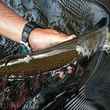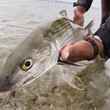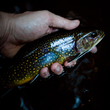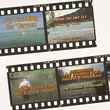I’m a self-styled fly-tier who’s likely better at imitating fly patterns that, to my repeated surprise, often catch fish, than I am at crafting my own creations.
No, they’re often not pretty. But, generally speaking, they’re pretty enough.
But, for the longest time, I struggled tying articulated streamer patterns—you know, the big, ugly suckers that cast like a wet diaper but tend to be the patterns that pull hog browns out from under log jams when nothing else seems to do the trick. The part of my brain where pragmatism dwells can be a bit difficult to access at times, and I struggled mightily to figure it out. When I finally did, it was a total face-palm moment.
Whether you’re tying full-on articulated patterns or just tying streamers with trailing “stinger” hooks, the secret isn’t in knots or, depending on the type of fish you’re after, in the material you use to connect the main body of the fly to trailing section. The secret is in the tying itself. In fact, good articulated patterns aren’t tied using knots at all.
Over the years, I’ve watched other vise-monkeys like me offer different methods for tying the lead hook to the trailing hook, or the body of the fly using articulated fly shanks to the stinger hook, and I’m convinced that I’ve finally stumbled upon the easiest method.
And, if you’re like me when it comes to tying flies, easier is better.
First, as I mentioned, it’s not about a knot. Instead, treat the material you’re using to connect the trailing hook just like any other material you might tie into a fly pattern. With your hook connected to your trailing line (I’ll get to the material shortly), simply place the line atop the lead hook or shank, and tie it down, starting at the bend in the hook and working your way to toward the hook eye.
Then, stretch the leftover material toward the bend, and tie back to the original tie-in point. This is where I like to dose the entire stretch of tied-in material with either a thin coat of head cement or, even better, a coat of very thin UV-activated resin. Splash the coating with a UV light and you’ve got yourself a virtually unbreakable connection between your lead shank and your trailing hook.

As for the line between the lead and the trailer, consider your target. For trout and bass, a nice segment of heavy mono (15-pound test or better) should work. For toothy critters, like pike, barracuda or bluefish, consider something different, like a stretch of 30-, 40-, or 50-pound Spiderwire.
And you have some options here. You can go with a single stretch of line, tied to the trailing hook eye in a somewhat traditional method, or you can choose to attach the trailing hook by looping the material through the hook eye and tying both ends of the material to the lead hook shank. Both work, but I prefer the latter, because I think it adds to the strength of the fly, both by providing two lengths of line to the trailing hook, and by giving it two attachments to the lead shank. Honestly, though, it’s a preference thing.
As for length, consider two things:
- The length of the material that stretches behind the lead hook or shank, like the marabou or the stretch of rabbit or bucktail … or whatever;
- And, whatever you choose to attach to the trailing hook, if anything at all (obviously, a stinger hook will be bare, and shouldn’t extend past the tail material tied to the lead shank) should cover the hook so it blends nicely with the material from the lead shank.
You can also double the durability of the fly by choosing to lash the trailing material to the trailing hook, much like you did to the lead hook. Rather than loop the material to the trailing hook eye, stretch it a bit farther down the shank and tie it in. Then, dose it with cement or resin. This adds more strength to the finished product, and for most angling situations, stronger is so much better.
No, it’s not rocket science. It’s actually a fairly easy method for crafting good articulated patterns, and for those who’ve spent time trying to use the knot method, this might seem overly simple. Give it a try and see if you don’t like the outcome. I know I like not tying knots which often break over time.






























Comments
Steve Brown / President replied on Permalink
Where possible I like to insert the ends of the trailer hook materials ( Spiderwire) through the eye of the lead hook then fold it back & lash it down. Very strong joint.
James Heimer replied on Permalink
I use 20 or 30 lb backing line instead of mono to make the hook-to-hook connection with a girth hitch like loop through the trailing hook eye and tied down on top of the lead hook or shank.
If using a lead hook, rather than a shank, be sure that when you cut the point off after tying the fly, file it down so that it won't inadvertently cut the line between the two parts of the fly.
Michael McKinley replied on Permalink
Check out stainless steel leader wire. I use 0.024 to 0.030 wire to make my own shanks. Buy some 0.018 diameter wire to make the connection between front hook and the shank or trailer hook. Easy to lash down, stiff, allows the shank to articulate easily, and $3.00 buys you 42 feet of the stuff. Each section to connect fly/shank is about 3 inches.
Play with the lashing down point; the rear wire can stick up or down or straight back.
Pages